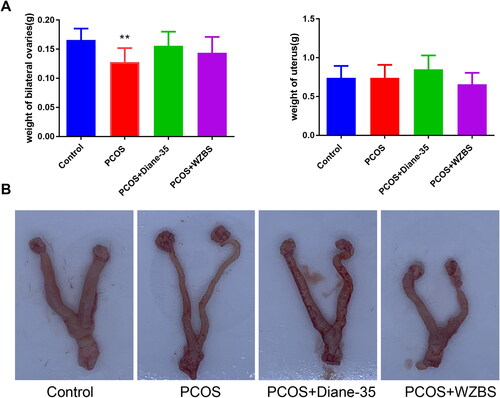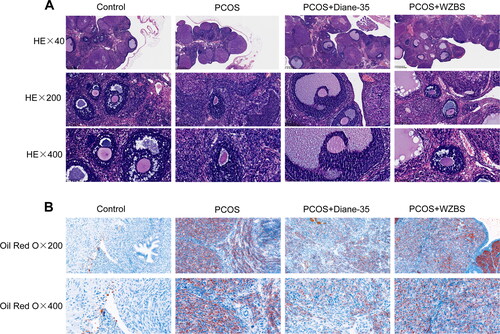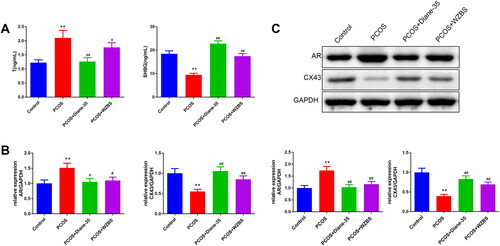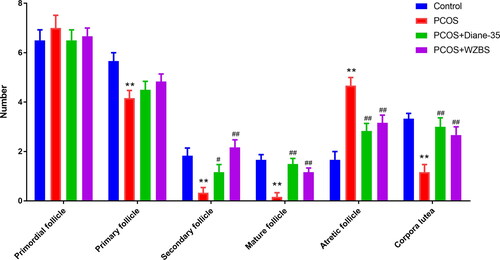Abstract
Objectives
The study aimed to explore the role and mechanism of WZBS recipe on PCOS.
Methods
PCOS model was established. After modeling, PCOS rats were intragastrically administered with Diane-35 or WZBS recipe (6.93 g/kg/d). Then, the ovarian and uterine morphology were observed, the estrous cycle was assessed. HE and oil red O staining were conducted for ovarian morphological analysis and counting ovarian follicle and corpora lutea number. Furthermore, the serum content of testosterone (T) and sex-hormone-binding globulin (SHBG) were assessed by ELISA kits. The androgen receptor (AR), CX43 mRNA and protein expression were measured by q-PCR and Western blot.
Results
WZBS recipe increased uterine implanted blastocysts, reduced cystic dilated follicles, and normalized estrous cycle in PCOS rats. Meanwhile, WZBS recipe alleviated ovarian injury, increased mature follicles and corpora lutea number in PCOS rats. Moreover, WZBS recipe decreased serum T content, AR expression and increased serum SHBG content, CX43 expression in PCOS rats.
Conclusions
This study reveals that WZBS recipe may attenuate PCOS by protecting follicular development via down-regulating AR.
Introduction
Polycystic ovary syndrome (PCOS) is one of the frequent causes of infertility in females with an incidence of about 6–21% [Citation1]. Excessive androgen, polycystic ovaries, and disordered ovulation are the most prominent features of PCOS [Citation2]. The adrenal gland and the ovaries of PCOS women produce excessive androgen, which will suppress the maturation of oocytes, arrest the growth of follicles, reduce the synthesis of estrogen, and then lead to disordered ovulation [Citation3]. At present, there are some drugs for treating excessive androgen, whereas most of the drugs have several side effects, such as long half-life, obviously difference between ovulation and pregnancy rates, high ovulation failure rate and expensive [Citation4]. The precise etiology of PCOS is still unclear, even though PCOS has been discovered a long time. Studies have shown that most PCOS females have abnormal follicular development [Citation2,Citation3]. Accumulating evidence suggests that follicular development is vital in the development and progression of PCOS. Thus, preventing abnormal follicular development may be a promising way to alleviate PCOS.
Traditional Chinese medicine (TCM) is the cultural treasure of China, which has been widely used to prevent and treat diseases for the advantages of high efficacy, affordability, minimal or no side effects [Citation5]. TCM is increasingly used by women to treat infertility and has been demonstrated to have beneficial therapeutic effects [Citation6]. For example, TCM could relieve PCOS by altering serum hormone levels, improving insulin resistance and recovering ovary morphological lesions [Citation7].Wuzibushen (WZBS) recipe, composed of dodder seed (Cuscuta chinensis), glossy privet fruit (Ligustrum lucidum), mulberry (Fructus mori), palmleaf raspberry fruit (Rubus idaeus L.) and barbary wolfberry fruit (Lycium fructus), is an experience prescription developed by the chief TCM practitioners and doctoral supervisors of the Tongde Hospital of Zhejiang Province. Previous studies have demonstrated that some compositions of WZBS recipe exert therapeutic benefit for infertility. For example, it is verified that dodder seed could alleviate granulosa cells dysfunction caused excessive androgen secretion and abnormal follicles formation [Citation8]. In addition, mulberry can enhance the endometrial environment to prevent infertility [Citation9]. Nevertheless, to date, the role and mechanism of WZBS recipe on PCOS have not been demonstrated.
In this study, we induced PCOS model by letrozole (LE) intragastrical administration in SD female rats and measured the relevant indicators to evaluate the role of WZBS recipe in LE-related PCOS, thus providing a scientific basis for the novel treatment of PCOS.
Materials and methods
Animals
Forty sexually mature SD female rats (6 weeks old, weighing 180–220 g) with normal estrous cycles were supplied by the Shanghai SLAC Laboratory Animal Co., Ltd. (China). All animal experiments were conducted with the Approval of Laboratory Animal Ethics Review Zhejiang Academy of Traditional Chinese Medicine (Approval No. 2019-069), and the experiments were conducted according to the guidelines of the Chinese Council on Animal Care. All rats were kept in an environment of controlled temperature (17–20 °C), humidity (50–70%) and light (12-h light/dark cycle) with ad libitum access to feed and water.
Experimental animal grouping and model establishment
After one week of adaptation, the rats were randomly assigned to 4 groups: the control, PCOS, PCOS + Diane-35 and PCOS + WZBS groups, with 8 rats in each group. Thereafter, the rats from the PCOS, PCOS + Diane-35 and PCOS + WZBS groups were intragastrically administered with 1 mg/kg/day of LE dissolved in 1% carboxymethyl cellulose (CMC; 2 ml/kg) for 21 consecutive days [Citation10]. The rats from the control group were intragastrically administered with equal volume of CMC for 21 consecutive days. Vaginal smear was used to monitor the estrous cycles of the rats to verify the success of the PCOS model. After finishing intragastrically administered with LE, the rats in PCOS + Diane-35 and PCOS + WZBS groups were given continuously intragastric administration with Diane-35 (0.104 g/kg/d) and WZBS recipe (6.93 g/kg/d) for 21 days, respectively, and the rest rats received equal volume of saline.
Sample collection
After 21 days of WZBS administration, the rats were anesthetized by sodium pentobarbital (40 mg/kg), blood samples were taken from the abdominal aorta and the serum was obtained by centrifugation, all samples were frozen at −80 °C fridge until analysis. After blood removal, the rats were euthanized, the bilateral ovaries and uterus were collected and weighed. One side of ovaries was used for HE and oil red O staining and the other side of ovaries were used for Western blot and qPCR detection.
Estrus cycle analysis
After the smears were obtained by gently swabbing the vagina of the rats, the collected cells were smeared, stained by Wright (Nanjing Jiancheng Technology Co., Ltd, China, 20181219) and the cell morphology was observed using a light microscope (×200 magnification).
Ovary histological analysis
Freshly dissected ovary samples were fixed with 10% formalin solution, embedded with paraffin, sliced into 5-µm-thick sections, and stained with HE. The slices were observed with a light microscope (×40, ×200 and ×400 magnification), the Nikon DS-U3 system was used to take photos.
Six representative HE stained sections from each group were chosen to measure the number of ovarian follicle (primordial, primary, secondary, mature and atretic follicle) as well as corpora lutea based on the standards established by Li et al. [Citation11]. In order to avoid repeated-counting, only follicles containing oocyte nuclei were counted.
For oil red O staining, 5-μm-thick frozen slices were washed by water, fixed with 4% formaldehyde for 30 min, rinsed by water again, and incubated with oil red O solution (Servicebio, China, G1016) for at least 1 h. The stained sections were washed by water and imaged with a light microscopy.
Enzyme-linked immunosorbent assay (ELISA)
The frozen serum samples were taken, and the ELISA kit was used to detect the serum level of testosterone (T) and sex-hormone-binding globulin (SHBG) (Biovalue, China, MM-0577R2; Biovalue, China, MM-0483R2) in strict accordance with the operation instructions.
Quantitative PCR (q-PCR)
The total RNA of ovarian tissues was extracted by Trizol reagent (Sangon Biotech, China, B511311). RNA reversely transcribed into cDNA by PrimeScript RT reagent kit (CWBIO, China, CW2569), and then the qPCR was conducted with SYBR Premix Ex TaqII (Takara, China, RR820A) in strict accordance with the directions. GAPDH was taken as a reference. 2−ΔΔCt method was used to determine the expression of relative genes. The list of primers used in this study was shown in .
Table 1. qRT-PCR primers
Western blot
Protein of ovarian tissues was extracted for Western blot analysis. Protein concentration for each sample was determined by the BCA protein assay kit (Solarbio, China, pc0020). Then, the protein samples were separated by SDS-PAGE and electrically transferred onto PVDF membranes. The membranes were blocked by 5% nonfat milk for 1.5 h at 37 °C, followed by incubation with primary antibodies against androgen receptor (AR) (Affinity, US, AF6137) and CX43 (Affinity, US, AF0137) at 4 °C overnight for 12 h. An antibody against GAPDH was used as the loading control. Subsequently, the membranes were washed and incubated with a horseradish peroxidase-conjugated secondary antibody for 1 h at 37 °C. Finally, the membranes were washed and developed by ECL (CLiNX, China, 610020-9Q). The densitometry analysis of the immunoreactive bands was performed by the Fuji ultrasonic-doppler velocity profile system and Image J program.
Statistical analysis
The data were expressed as mean ± standard deviation and were analyzed by SPSS 16.0. One-way ANOVA and SNK test were applied for multi-group comparison. Kruskal-Wallis H test was applied if variances were not equal. p < 0.05 was considered a statistically significant difference.
Results
WZBS recipe alleviated the ovarian and uterine injuries in PCOS rats
To investigate the therapeutic effect of WZBS recipe in PCOS, we compared the weight of bilateral ovaries and uterus in the four groups. Relative to the control group, the lower bilateral ovaries weight was observed in the PCOS group. Moreover, the decreased bilateral ovaries weight in the PCOS rats was increased by the treatment of WZBS recipe or Diane-35 (). However, there was no remarkable difference in uterus weigh across these groups.
Figure 1. WZBS recipe alleviated the ovarian and uterine injuries of the LE-induced PCOS rats. (A) WZBS recipe significantly increased the weight of bilateral ovaries but had no effect on the weight of uterus in the PCOS rats. (B) WZBS recipe improved the ovarian and uterine morphology of the PCOS rats. *p < 0.05 and **p < 0.01 vs. Control. Data were presented as mean ± SD. n = 8.

Meanwhile, the ovarian and uterine morphology of the rats from all groups were observed (). Compared with the control group, rats in the PCOS group had more cystic dilated follicles and fewer uterine implanted blastocysts. Remarkably, the PCOS rats treated with WZBS recipe or Diane-35 improved the morphology evidently.
WZBS recipe ameliorated disordered estrous cycle induced by LE in PCOS rats
Each stage of the estrous cycle in rats was assessed by the presence of white blood cell, nucleated epithelial cell, non-nucleated cornified cell [Citation12]. In the diestrous phase, most of the vaginal cell of rats is white blood cell. In the proestrous phase, most of the vaginal cell of rats is nucleated epithelial cell. During the estrous phase, most of the vaginal cell of rats is non-nucleated cornified cell. In the metestrus phase, the vagina cell of rats is greatly reduced. As shown in , the rats in the control group had a normal estrous cycle while the rats in the PCOS had a disordered estrous cycle, and mostly remained at the diestrous phase. Notably, after treating with Diane-35 or WZBS recipe, the estrous cycle of PCOS rats gradually recovered to normal.
WZBS recipe ameliorated ovary histopathological injuries of PCOS rats
HE and oil red O staining were conducted to observe the pathology changes of ovaries in rats. The results of HE staining exhibited that the rats from the control group showed normal structure of ovarian tissues. However, the ovarian tissue structure of PCOS rats was disorganized, with obvious cystic dilatation follicles. In addition, the number of granulosa cell layers reduced evidently. After treating with either WZBS recipe or Diane-35, the damaged ovarian tissue structure was partly restored ().
Figure 3. WZBS recipe ameliorated ovary histopathological injuries of PCOS rats. (A) The representative images of ovarian tissue of rats stained with HE (×40, ×200, ×400, respectively). (B) The representative images of ovarian tissue of rats stained with oil red O (×200, ×400, respectively). n = 3.

As for oil red O staining, the control group exhibited fewer lipid droplets but the PCOS group displayed profound lipid droplets accumulatin. However, after WZBS recipe or Diane-35 administration, the lipid droplets accumulatin in ovarian tissues of PCOS rats were effectively reduced ().
As showed in , HE staining of ovaries found that there was no evident difference in the number of primordial follicles between control and PCOS groups(p > 0.05), however, there was a sharp decrease in the number of primary, secondary, mature follicles, corpora lutea and an excessive increase in the number of the atretic follicles in the PCOS group (p < 0.01). After treating with WZBS recipe or Diane-35, the number of secondary, mature follicles and corpora lutea distinctly increased whereas the number of atretic follicles evidently decreased (p < 0.01).
WZBS recipe treatment decreased the T content and increased the SHBG content in PCOS rats
The content of T and SHBG in the serum of the rats was measured by ELISA. Compared to the control group, the T content in the PCOS rats obviously increased, while the SHBG content was obviously decreased (p < 0.01). However, WZBS recipe or Diane-35 administration, distinctly reversed the LE-induced increase in T and decrease in SHBG (< 0.05).
Figure 5. WZBS recipe affected the serum content of T and SHBG, the expression of AR and CX43 in LE-induced PCOS rats. (A) WZBS recipe decreased serum T content and increased serum SHBG content in the PCOS rats. (B) WZBS recipe decreased AR mRNA expression and increased CX43 mRNA expression in the PCOS rats. (C) WZBS recipe decreased AR protein expression and increased CX43 protein expression in the PCOS rats.*p < 0.05 and **p < 0.01 vs. Control, #p < 0.05 and ##p < 0.01 vs. PCOS. Data were presented as mean ± SD. n = 3.

WZBS recipe elevated CX43 expression and reduced AR expression in PCOS rats
To examine expression of CX43 and AR in the ovaries of rats in each group, q-PCR and western blot were conducted. As presented in , relative to control group, the expression of AR mRNA was elevated, while that of CX43 was decreased in PCOS rats (p < 0.01), and WZBS recipe or Diane-35 treatment evidently reversed these changes (p < 0.05). The results obtained by western blot were similar to those of q-PCR ().
Discussion
The LE-stimulated PCOS model is an excellent model as animals can develop numerous features of human PCOS [Citation13,Citation14]. LE works via inhibiting aromatase, causing a decrease of conversion from androgens to estrogens, which leads to an excessive accumulation of androgens in the ovary [Citation15]. The change of hormones will stop even negatively impact the follicular maturation, and then cause anovulation [Citation16]. As would be expected, from the present study, we observed that after 21 consecutive days intragastrically administration with LE successfully induced PCOS in rats, which was consistent with previous studies [Citation17,Citation18].
PCOS is a common endocrine disorder around the world [Citation19]. Ovulation disorder is a typical feature of PCOS, which exists in about 75% of PCOS patients [Citation20]. It is generally accepted that the development of ovarian follicular is directly correlated to ovulation [Citation21]. In normal conditions, ovulation would occur only when primordial follicles develop into dominant follicles and continue to grow until mature, however, in individuals who suffer PCOS, the follicular development is frequently arrested [Citation22]. In this study, LE intragastrically administration caused typical manifestations of PCOS, including decreased bilateral ovaries weight, poor condition of ovaries and uterus, disordered estrous cycle, evident ovary injury, abnormal number of ovarian follicles and corpora lutea. After treating with WZBS recipe or Diane-35, the symptoms were all evidently relieved. Hence, our findings suggested that WZBS recipe had a protective effect on LE-induced PCOS.
TCM has been extensively used and accepted worldwide due to its remarkable efficacy in treating a number of diseases. WZBS recipe, one of the most important TCM, which can promote blood circulation, sufficient Kidney-Qi, smooth the liver and invigorate the spleen in PCOS without toxic side effects [Citation9]. Flavonoids have been suggested for the use of treating reproductive dysfunction, mainly because of their antioxidant and hormonal properties [Citation23]. Fatty acids had an effective role in decreasing serum androgen levels [Citation24]. Meanwhile, Tian et al. revealed that phenethanol glycosides could improve the sex hormone disorder in menopausal syndrome [Citation25]. T, an anabolic steroid hormone, is one of the most active androgen of females [Citation26]. T content in serum is always viewed as a good indicator to assess androgen activity [Citation27]. SHBG is a kind of carrier protein for androgen and estrogen [Citation28]. Due to the higher affinity of SHBG for androgen, the change of SHBG content has a strong influence on androgen metabolism and activity. Previous study found that SHBG can bind to T and decrease the free T level in the blood [Citation29]. In this study, we found that the T content in the PCOS rats was obviously increased, while the SHBG content was obviously decreased. However, after the PCOS rats were treated with WZBS recipe, the changed content of T and SHBG were reversed, which implied that WZBS recipe could affect the activity of androgen in PCOS rats.
AR is a steroid receptor, belonging to the nuclear receptor superfamily of proteins [Citation30]. As a nuclear transcription factor, AR expression level is determined by the activity androgen. The androgen-AR signaling pathway has a two-way regulation effect in the development of follicles [Citation10], during the early stage of follicular development, AR expression promotes follicular recruitment and growth. However, during the late stage of follicular development, the growth of follicles, the maturation of oocyte and the ovulation will be inhibited if AR is still heavily expressed. In addition, Mei et al. performed experiment on mice and found that AR could regulate the expression of CX43 to affect follicular growth, development and expulsion [Citation31], which is in accordance with the results found in our experiment. In this study, the expression of AR was decreased and the expression of CX43 was elevated after LE-induced PCOS rats treated with WZBS recipe, which indicated that WZBS recipe could improve PCOS by protecting follicular development via the regulation of the expression of AR.
Nevertheless, the present study only explores the role of PCOS in the animal model, which is short of corresponding in vitro experiment to validate the molecular mechanism. In the future, we will conduct these experiments to better demonstrate the role of WZBS recipe in PCOS.
Conclusion
In conclusion, our study demonstrates that the protective effect of WZBS recipe on follicular development via regulating AR in PCOS. Thus, WZBS recipe, as an adjuvant therapy for PCOS patients, presents broad therapeutic potential and warrants further investigation.
Data availability statement
All the data are contained in the manuscript.
Disclosure statement
The authors report there are no competing interests to declare.
Additional information
Funding
References
- Abbott D, Rayome B, Dumesic D, et al. Clustering of PCOS-like traits in naturally hyperandrogenic female rhesus monkeys. Hum Reprod. 2017;32(4):1–7.
- Secreto G, Sieri S, Agnoli C, et al. A novel approach to breast cancer prevention: reducing excessive ovarian androgen production in elderly women. Breast Cancer Res Treat. 2016;158(3):553–561.
- Tee M, Speek M, Legeza B, et al. Alternative splicing of DENND1A, a PCOS candidate gene, generates variant 2. Mol Cell Endocrinol. 2016;434:25–35.
- Choi J, Jang M, Kim E, et al. Korean red ginseng alleviates dehydroepiandrosterone-induced polycystic ovarian syndrome in rats via its antiinflammatory and antioxidant activities. J Ginseng Res. 2020;44(6):790–798.
- Li C, Li Q, Xu J, et al. The efficacy and safety of compound danshen dripping pill combined with percutaneous coronary intervention for coronary heart disease. Evid Based Complement Alternat Med. 2020;2020(8):5067137.
- Jiang X, Yan H, Zhong X, et al. Effect of bushen yutai recipe on IVF patients subjected to mild ovarian stimulation. Front Med (Lausanne). 2020;7:541537.
- Zhao H, Zhou D, Chen Y, et al. Beneficial effects of Heqi san on rat model of polycystic ovary syndrome through the PI3K/AKT pathway. DARU J. Pharm. Sci. 2017;25(1):21.
- Xu Y, Pan CS, Li Q, et al. The ameliorating effects of bushen huatan granules and kunling wan on polycystic ovary syndrome induced by dehydroepiandrosterone in rats. Front Physiol. 2021;12(3):257.
- Jeon S, Liu QF, Cai H, et al. Administration of a herbal formulation enhanced blastocyst implantation via IκB activation in mouse endometrium. Chin Med. 2020;15(1):112.
- Xu G, Zhang A, Liu J, et al. Effects of electroacupuncture on ovarian expression of the androgen receptor and connexin 43 in rats with Letrozole-Induced polycystic ovaries. Evid-Based Complement Altern Med. 2020;2020(17):1–13.
- Li J, Ye Y, Zhang R, et al. Robo1/2 regulate follicle atresia through manipulating granulosa cell apoptosis in mice. Sci Rep. 2015;5(1):9720.
- Omar S, Samad AAAE, Omar S, et al. Modified vaginal smear cytology for the determination of the rat estrous cycle phases, versus ordinary papanicolaou technique, verified by light and scanning electron microscopic examination of the endometrium. Egypt J Histol. 2007;30(2):397–408.
- Karateke A, Dokuyucu R, Dogan H, et al. Investigation of therapeutic effects of erdosteine on polycystic ovary syndrome in a rat model. Med Princ Pract. 2018;27(6):515–522.
- Sherafatmanesh S, Ekramzadeh M, Tanideh N, et al. Therapies. The effects of thylakoid-rich spinach extract and aqueous extract of caraway (Carum carvi L.) in letrozole-induced polycystic ovarian syndrome rats. BMC Complement Med Therap. 2020;20(1):249.
- Garcia-Velasco J, Moreno L, Pacheco A, et al. The aromatase inhibitor letrozole increases the concentration of intraovarian androgens and improves in vitro fertilization outcome in low responder patients: a pilot study. Fertil Steril. 2005;84(1):82–87.
- Gopal M, Duntley S, Uhles M, et al. The role of obesity in the increased prevalence of obstructive sleep apnea syndrome in patients with polycystic ovarian syndrome. Sleep Med. 2002;3(5):401–404.
- Rajan RK, Ssk M, Balaji BJPB. Soy isoflavones exert beneficial effects on letrozole-induced rat polycystic ovary syndrome (PCOS) model through anti-androgenic mechanism. Pharm Biol. 2017;55(1):242–251.
- Yang H, Lee SY, Lee SR, et al. Therapeutic effect of ecklonia cava extract in Letrozole-Induced polycystic ovary syndrome rats. Front Pharmacol. 2018;9(19):1325.
- Crespo RP, Bachega T, Mendon ? B, et al. An update of genetic basis of PCOS pathogenesis. Archendocrinolmetab. 2018;62(3):352–361.
- Li X, Pishdari B, Peng C, et al. Regulation of androgen receptor expression alters AMPK phosphorylation in the endometrium: in vivo and in vitro studies in women with polycystic ovary syndrome. Int J Biol Sci. 2015;11(12):1376–1389.
- Saxena R, Georgopoulos NA, Braaten TJ, et al. Han Chinese polycystic ovary syndrome risk variants in women of european ancestry: relationship to FSH levels and glucose tolerance. Hum Reprod. 2015;30(6):1454–1459.
- Aftabsavad S, Noormohammadi Z, Moini A, et al. Effect of bisphenol a on alterations of ICAM-1 and HLA-G genes expression and DNA methylation profiles in cumulus cells of infertile women with poor response to ovarian stimulation. Sci Rep. 2021;11(1):9595.
- Campos MS, Silva JPA, Lima DS, et al. Short-term exposure to chrysin promotes proliferative responses in the ventral male prostate and female prostate of adult gerbils. Int J Exp Path. 2019;100(1):192–201.
- Komal F, Khan MK, Imran M, et al. Impact of different omega-3 fatty acid sources on lipid, hormonal, blood glucose, weight gain and histopathological damages profile in PCOS rat model. J Transl Med. 2020;18(1):349.
- Tian S, Miao M, Bai M, et al. Phenylethanoid glycosides of cistanche on menopausal syndrome model in mice. Saudi Pharm J. 2017;25(4):537.
- Xiao J, Song J, Sa Y, et al. The mechanisms of improving IVF outcomes of Liu-Wei-Di-Huang pill acting on DOR patients. Evid Based Complement Alternat Med. 2020;2020:5183017.
- Baralić K, BuhaDjordjevic A, Živančević K, et al. Toxic effects of the mixture of phthalates and bisphenol A-subacute oral toxicity study in Wistar rats. Int J Environ Res Public Health. 2020;17(3):746.
- Hang D, Srlie KA, Ma W, et al. Coffee consumption and plasma biomarkers of metabolic and inflammatory pathways in US health professionals. Am J Clin Nutr. 2019;109(3):3.
- Stenqvist TB, Torstveit MK, Faber J, et al. Impact of a 4-Week intensified endurance training intervention on markers of relative energy deficiency in sport (RED-S) and performance among Well-Trained male cyclists. Front Endocrinol. 2020;11(706):512365.
- Wang M, Liu X, Chen Z, et al. Downregulation of lysine specific demethylase 1 enhances the sensitivity of hormone sensitive prostate cancer cells to androgen deprivation therapy. Oncol Lett. 2020;21(2):93.
- Mei Y, Li J, An Y, et al. Effects of androgen on immunohistochemical localization of androgen receptor and connexin 43 in mouse ovary. Tissue Cell. 2015;47(5):526–532.


